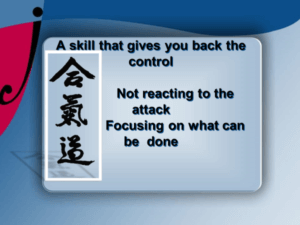Difficult conversations plague professionals across the board. Supervisors reprimand you in front of others. Coworkers tactlessly reject your ideas. Additionally, clients lash out at people to get what they want.
Rather than pushing back or getting even, you can gain control of the situation. In fact, seething in silence doesn’t help to diplomatically deal with unkind people. The solution is called Verbal Aikido. It’s a communications technique that won’t get you fired.
What is Aikido?
Aikido is a Japanese form of self-defense. It uses non-resistance to debilitate an opponent’s strength. The Aikido practitioner seeks to counter attacks without bringing harm to the attacker. And creates balance. In other words, when pushed, you pull; when pulled, you push.
This technique is just as effective with verbal attacks. It allows you to respond to a verbal attack by accepting the comment. Additionally, redirecting it, and reaffirming your stance in a positive manner. Avoid being hostile and building emotional barriers!
Verbal Aikido Basics to Get In Control of Difficult Conversations
The cardinal rule of Verbal Aikido is to not repeat the accusation. By doing so, you absorb the negative message.
Verbal Aikido EXAMPLE #1 to Gain Control of Difficult Conversations:
If someone questions a business purchase with an accusatory, “Why are you wasting the company’s money?” Don’t respond by yelling, “I’m not wasting the company’s money! I need these items to perform my job!”
Such a response reinforces the blame on you. Instead, a Verbal Aikido practitioner would redirect the comment by saying, “Let me tell you how I invested the company’s money.”
Your Verbal Aikido response also reaffirms your control over unneeded emotional responses. And gives the other person nothing to push against.
Verbal Aikido EXAMPLE #2 to Gain Control of Difficult Conversations:
Suppose you’re giving constructive criticism to a male co-worker who tells you, “What I did is perfectly fine. You’re just too emotional. All you women are alike.”
Instead of becoming “heated” and reinforcing his claim, say, “I agree. I can overreact at times. Let me explain why I feel this way about the situation.”
This response accepts the basis of the situation without absorbing the negative aspects. In fact, you redirect the accusation by agreeing. The response also reaffirms the other person’s feelings of frustration. As a result, you diffuse the confrontation and can work toward repairing the situation.
Here’s Part 2 of How to Take Control of Difficult Conversations
Get the Support You Need!
Are you a Department Manager or Leader who has an employee who is a valuable member of the team but struggles with effective communication which results in either bullying tactics or shutting down?
If you’re ready to explore increased:
- Self-confidence
- Greater job satisfaction
- More fulfillment with your career
You need to learn how to Kick Conflict to the Curb™!
Schedule your appointment for your complimentary consultation to see if private coaching or group facilitation is the best fit for you or your direct reports.


